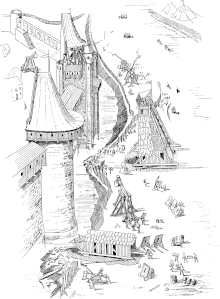Castles of England/Methods of Attack
In this chapter we look at the ways a castle could be attacked, and the weapons that were used. As has been the case throughout history the development of weapons was faster than the means of defence resulting in the eventual obsolescence of the castle.
An assault on a castle usually took one of two forms: an attempt to storm the castle or the laying of a siege in the hope of driving the defenders to surrender.
The Siege

If a castle was held by a reasonable sized force, it would be much more difficult to capture without a siege, although treachery by a member of the castle garrison by, say, opening the gates to the enemy, was certainly not unknown. In the medieval period, it was virtually impossible to launch a surprise attack as an army simply could not advance quickly enough without warning being passed to the castle.
Once the siege had begun there were a number of ways the attackers could try and defeat the castle. They could:
- Use siege engines to try and smash down the walls
- Use siege equipment, like ladders and wheeled ramps, to try and scale the walls
- Tunnel under the walls to undermine them
- Use a battering ram to smash down the gates or strong walls
- Set fire to the walls, or fling burning material inside the walls to set the buildings inside alight
- Attempt to starve out the defenders
- Attempt to spread disease through the castle by flinging sick animals or dead bodies over the walls
Siege Engines
Siege engines were used by the attackers either to try and kill the defenders directly, or weaken the castle to the point where it could be successfully stormed.
Mangonel

The mangonel was similar in design to a large catapult and used the torsion in a twisted rope to power the arm. Its main use was to attack the castle walls rather than the defenders as it hurled stones or other ammunition at high speed but at too shallow an angle to reach the top of the wall. The mangonel had a bucket at one end that could be filled with different materials depending on the situation. For example, burning barrels of pitch could have been thrown to set fire to the bottom of the walls with the intention of weakening the cement, making the wall easier to collapse. The mangonel was fairly inaccurate making it best suited to attacks on stretches of wall rather than pinpoint attacks.
Trebuchet

The trebuchet was a later development and supplanted the mangonel due to its greater power and accuracy. It was also more flexible, being capable of striking the castle walls as well as lifting objects over the walls to attack the interior of the castle. It used a counterweight to drive the arm, providing more power than the twisted rope used by mangonels. It also had a sling to hold the payload which had a mechanism for releasing it at the right point to achieve the maximum range. Records of the use of trebuchets suggest that the largest could fire rocks of up to 1,500 kg (although smaller stones must surely have been more typically used) and could achieve a rate of fire of one stone every 15 seconds. The maximum range varied but was probably between 200 and 300 feet.
The trebuchet was the most advanced of the siege engines and was not replaced until the advent of gunpowder.
A trebuchet constructed from 13th century plans in 2005 stood some 18 meters high and weighed more than 22 tons, giving some idea of the enormous scale of these weapons. Given this, it is likely they were either broken down for transport or fully assembled on site.
Ballista

The ballista was in use in Roman times. It was similar in design to a crossbow and was used to fire bolts of iron or stones. It had mainly fallen into disuse having been replaced by the more effective trebuchet and mangonel.
The siege engine could be used to throw decaying or diseased bodies over the wall in the hope of infecting and weakening the castle garrison.
Mining
Mining, digging under a castle's walls, could be done for two reasons. The first, and most common, reason was to weaken the wall above the mine. The attackers would tunnel underneath the wall, shoring up the tunnel with timber props. Once the mine was complete, a fire would be set to burn out the props and collapse the tunnel, hopefully bringing the wall down. A mine could also be sunk to build a route into the castle for the attackers to launch a surprise attack. If a mine was suspected, the defenders could dig a counter mine.
Burning
Early Motte and Bailey castles were constructed of wood, making fire an effective weapon. The fire could be set in a number of ways, usually by either building a fire against the wall or by launching burning arrows into the castle, using archers. Fire was a much less effective weapon against a stone castle. Although a fire could be set amongst the timber buildings within the bailey, it was often out of range of an arrow and easily extinguished by the defenders. William the conqueror ordered for all new castles to be built out of stone to resolve the problem.
Direct Assault
There are a number of ways of assaulting a castle: over the top of the walls using towers or ladders, under the walls using a mine, or through the walls using a battering ram, pickaxes or other tools.
Siege Tower
A siege tower is a mobile tower, usually constructed from wood, that provides protection for those attacking the castle while allowing them to gain access over the walls. The tower was sometimes coated with water-soaked hides to reduce the risk of fire being set by fire arrows or Greek fire. Towers became larger and more sophisticated over the years. By the time of the siege of Kenilworth Castle in 1266 the towers in use could hold 11 catapults and over 200 archers each.
Siege towers fell out of use with the development of the cannon. The cannon was capable of smashing the high walls of the castle, removing the need for the attackers to enter the castle over the walls.
Sow
A sow is a mobile armoured shelter. They protected attackers working at the base of the castle wall from missiles dropped from above by the defenders. They were often used to allow workers to approach and fill the moat to create a causeway so that the siege tower could be maneuvered to approach the wall.
Battering Ram

A battering ram is a designed to break the gates or walls of a castle through repeated heavy impacts. The first rams were large tree trunks carried by hand and crashed into the wall as hard as possible.
Later more sophisticated siege engines were built with wheels that enclosed the ram under an arrow-proof roof. This allowed the attacker's to move the ram close to the wall or gate protected from the defenders. The ram itself would be hung by chains or ropes enabling it to be swung freely.
Rams were most effective against wooden gates or soft stone walls. Harder stone, such as granite, were much more resistant but could still be defeated eventually by a ram.